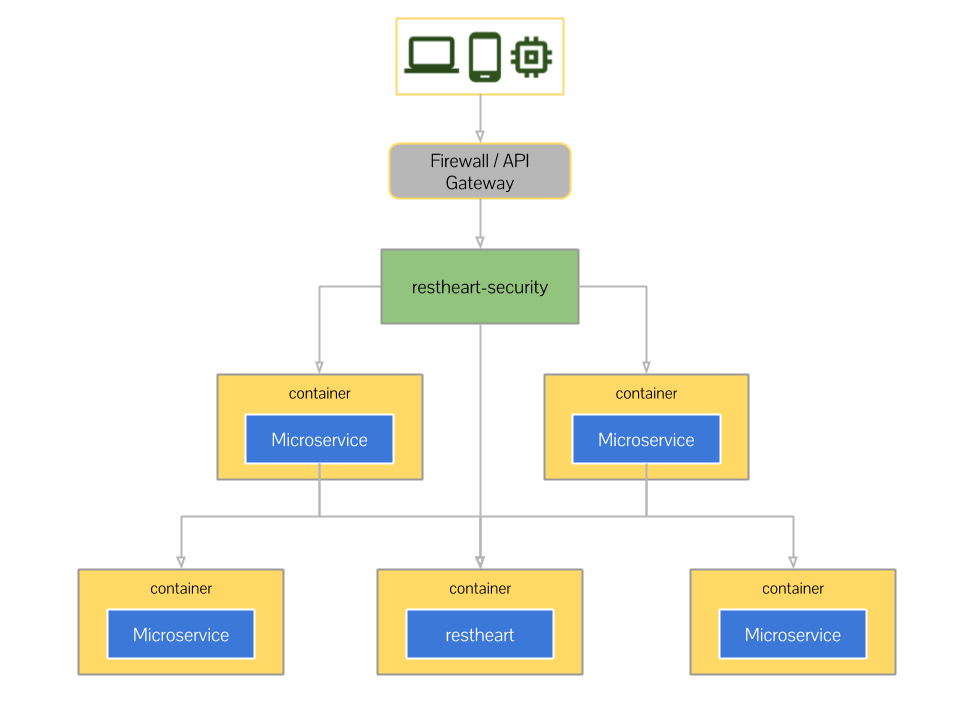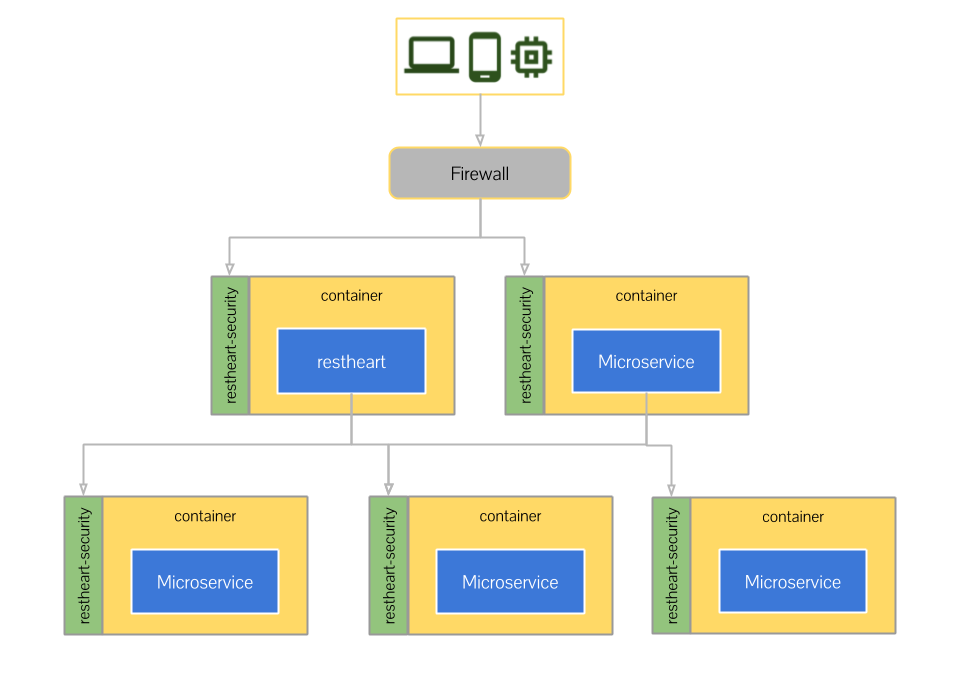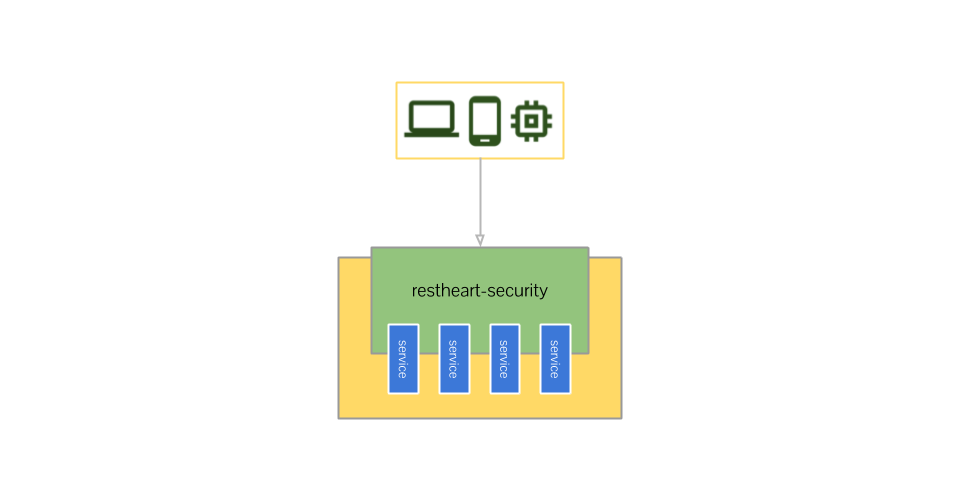Security Overview
Introduction
restheart-security is the security service for RESTHeart.
It acts as a reverse proxy for HTTP resources, providing Authentication and Authorization services.
restheart-security enables developers to configure security policies in standardized micro-gateway instances that are external to API and micro-services implementations, avoiding coding security functions and a centralized gateway where scalability is a key concern.
restheart-security can also be used as a micro-gateway for Identity and Access Management in any HTTP-based micro-services architecture.
Think about restheart-security as the “brick” that you put in front of your API and micro-services to protect them.
restheart-security is built around a pluggable architecture. It comes with a strong security implementation but you can easily extend it by implementing plugins.
Building a plugin is as easy as implementing a simple interface and edit a configuration file. Plugins also allow to quickly implement and deploy secure Web Services.
Features
- Identity and Access Management at HTTP protocol level.
- Placement within Docker containers, on the network layer and embeddable in Java applications.
- Can be extended via easy-to-implement plugins.
- Allows to quickly implement secured Web Services.
- Basic, Digest and Token Authentication. Other authentication methods can be added with plugins.
- Roles based Authorization with a powerful permission definition language. Other authorization methods can be added with plugins.
- Solid multi-threading, non-blocking architecture.
- High performance.
- Small memory footprint.
- Straightforward configuration.
Use cases
restheart-security on the network layer
The following diagram shows a single instance of restheart-security placed on the network layer, in front of the resources to be protected. It acts as a centralized security policy enforcer.

restheart-security within containers
The following diagram shows restheart-security used as a sidecar proxy within each container pod. Each micro-service is protected by an instance of restheart-security with its own dedicated security policy.

restheart-security embedded
The following diagram shows restheart-security used to implement a simple micro-service using service extensions.

How it works
The restheart-security.yml configuration file allows defining listeners and proxied resources in the first place.
As an example, we are going to securely expose the resources of a RESTHeart server and Web Server running on a private network.
The following options set a HTTPS listener bound to the public ip of domain.io.
https-listener: true
https-host: domain.io
https-port: 443
The two hosts in private network 10.0.1.0/24 are:
- the RESTHeart server running on host
10.0.1.1that exposes the collection/db/coll - the web server running on host
10.0.1.2bound to URI/web
We proxy them as follows:
proxies:
- location: /api
proxy-pass: https://10.0.0.1/db/coll
- location: /
proxy-pass: https://10.0.0.2/web
As a result, the URLs https://domain.io and https://domain.io/api are proxied to the resources specified by the proxy-pass URLs. All requests from the external network pass through restheart-security that enforces authentication and authorization.
GET /index.html HTTP/1.1
HTTP/1.1 401 Unauthorized
GET https://domain.io/api HTTP/1.1
HTTP/1.1 401 Unauthorized
With the default configuration restheart-security uses the Basic Authentication with credentials and permission defined in users.yml and acl.yml configuration files respectively:
users.yml
users:
- userid: user
password: secret
roles: [web, api]
acl.yml
permissions:
# Users with role 'web' can GET web resources
- role: web
predicate: path-prefix[path=/] and not path-prefix[path=/api] and method[GET]
# Users with role 'api' can GET and POST /api resources
- role: api
predicate: path-prefix[path=/api] and (method[GET] or method[POST])
GET /index.html HTTP/1.1
Authorization: Basic dXNlcjpzZWNyZXQ=
HTTP/1.1 200 OK
...
GET /api HTTP/1.1
Authorization: Basic dXNlcjpzZWNyZXQ=
HTTP/1.1 200 OK
...
Tutorial
To follow this tutorial you need httpie, a modern command line HTTP client made in Python which is easy to use and produces a colorized and indented output.
Add to restheart-platform-security.yml the following proxy:
proxies:
- location: /secho
proxy-pass:
- http://localhost:8080/echo
the service /echo just echoes back the request (URL, query parameters, body and headers). It is defined in the configuration file as follows:
services:
- implementation-class: org.restheart.security.plugins.services.EchoService
uri: /echo
secured: false
Note that /echo is not secured and can be invoked without restrictions.
$ http -f 127.0.0.1:8080/echo?qparam=value header:value a=1 b=2
HTTP/1.1 200 OK
Access-Control-Allow-Credentials: true
Access-Control-Allow-Origin: *
Access-Control-Expose-Headers: Location
Access-Control-Expose-Headers: Location, ETag, Auth-Token, Auth-Token-Valid-Until, Auth-Token-Location, X-Powered-By
Connection: keep-alive
Content-Encoding: gzip
Content-Length: 341
Content-Type: application/json
Date: Mon, 18 Feb 2019 17:25:19 GMT
X-Powered-By: restheart.org
{
"URL": "http://127.0.0.1:8080/echo",
"content": "a=1&b=2",
"headers": {
"Accept": [
"*/*"
],
"Accept-Encoding": [
"gzip, deflate"
],
"Connection": [
"keep-alive"
],
"Content-Length": [
"7"
],
"Content-Type": [
"application/x-www-form-urlencoded; charset=utf-8"
],
"Host": [
"127.0.0.1:8080"
],
"User-Agent": [
"HTTPie/1.0.2"
],
"header": [
"value"
]
},
"method": "POST",
"note": "showing up to 20 bytes of the request content",
"prop2": "property added by example response interceptor",
"qparams": {
"pagesize": [
"0"
],
"qparam": [
"value"
]
}
}
Let’s try now to invoke /secho (please note the leading ‘s’) without passing authentication credentials. This will fail with 401 Unauthorized HTTP response.
$ http -f 127.0.0.1:8080/secho?qparam=value header:value a=1 b=2
HTTP/1.1 401 Unauthorized
Connection: keep-alive
Content-Length: 0
Date: Mon, 18 Feb 2019 17:26:04 GMT
WWW-Authenticate: Basic realm="RESTHeart Realm"
WWW-Authenticate: Digest realm="RESTHeart Realm",domain="localhost",nonce="Z+fsw9eFwPgNMTU1MDUxMDc2NDA2NmFWzLOw/aaHdtjyi0jm5uE=",opaque="00000000000000000000000000000000",algorithm=MD5,qop="auth"
Let’s try now to pass credentials via basic authentication. The user admin is defined in the users.yml file.
$ http -a admin:changeit -f 127.0.0.1:8080/secho?qparam=value header:value a=1 b=2
HTTP/1.1 200 OK
Access-Control-Allow-Credentials: true
Access-Control-Allow-Origin: *
Access-Control-Expose-Headers: Location
Access-Control-Expose-Headers: Location, ETag, Auth-Token, Auth-Token-Valid-Until, Auth-Token-Location, X-Powered-By
Auth-Token: 5iojkf21pdul7layo3qultyes7qyt8obdm1u67hkmnw6l39ckm
Auth-Token-Location: /tokens/admin
Auth-Token-Valid-Until: 2019-02-18T17:41:25.142209Z
Connection: keep-alive
Content-Encoding: gzip
Content-Length: 427
Content-Type: application/json
Date: Mon, 18 Feb 2019 17:26:25 GMT
X-Powered-By: restheart.org
{
"URL": "http://localhost:8080/echo",
"content": "a=1&b=2",
"headers": {
"Accept": [
"*/*"
],
"Accept-Encoding": [
"gzip, deflate"
],
"Connection": [
"keep-alive"
],
"Content-Length": [
"7"
],
"Content-Type": [
"application/x-www-form-urlencoded; charset=utf-8"
],
"Host": [
"localhost:8080"
],
"User-Agent": [
"HTTPie/1.0.2"
],
"X-Forwarded-Account-Id": [
"admin"
],
"X-Forwarded-Account-Roles": [
"user,admin"
],
"X-Forwarded-For": [
"127.0.0.1"
],
"X-Forwarded-Host": [
"127.0.0.1:8080"
],
"X-Forwarded-Port": [
"8080"
],
"X-Forwarded-Proto": [
"http"
],
"X-Forwarded-Server": [
"127.0.0.1"
],
"header": [
"value"
]
},
"method": "POST",
"note": "showing up to 20 bytes of the request content",
"prop2": "property added by example response interceptor",
"qparams": {
"pagesize": [
"0"
],
"qparam": [
"value"
]
}
}
We can note that restheart-security:
- has checked the credential specified in
users.ymlpassed via Basic Authentication and proxied the request - has determined the account roles. The proxied request includes the headers
X-Forwarded-Account-IdandX-Forwarded-Account-Roles. - has checked the permission specified in
acl.ymlfor the account roles and determined that the request could be executed. - the response headers include the header
Auth-Token. Its value can be used in place of the actual password in the Basic Authentication until its expiration. This is useful in Web Applications, for storing in the browser the less sensitive auth token instead of full username and password.
Understanding restheart-security
In restheart-security everything is a plugin including Authentication Mechanisms, Authenticators, Authorizers, Token Managers and Services.

Different Authentication Mechanism manage different authentication schemes. An example is BasicAuthMechanism that handles the Basic Authentication scheme. It extracts the credentials from a request header and passes them to the an Authenticator for verification.
A different example is the IdentityAuthMechanism that binds the request to a single identity specified by configuration. This Authentication Mechanism does not require an Authenticator to build the account.
restheart-security allows defining several mechanism. As an in-bound request is received, the authenticate() method is called on each mechanism in turn until one of the following occurs:
- A mechanism successfully authenticates the incoming request → the request proceeds to Authorization phase;
- The list of mechanisms is exhausted → the request fails with code
401 Unauthorized.
The Authenticator verifies the credentials extracted from the request by Authentication Mechanism. For instance, the BasicAuthMechanism extracts the credentials from the request in the form of id and password. The Authenticator can check these credentials against a database or a LDAP server. Note that some Authentication Mechanisms don’t actually rely on a Authenticator to build the Account.
The Authorizer is responsible of checking if the user can actually perform the request against an Access Control List. For instance the RequestPredicatesAuthorizer checks if the request is allowed by looking at the role based permissions defined using the undertow predicate definition language.
The Token Manager is responsible of generating and validating an auth-token. When a client successfully authenticates, the Token Manager generates an auth-token that is returned in the Auth-Token response header. It can be used to authenticate further requests. This requires an Authentication Manager to handle it using the Token Manager for token validation.
A Service is a quick way of implementing Web Services to expose additional custom logic.